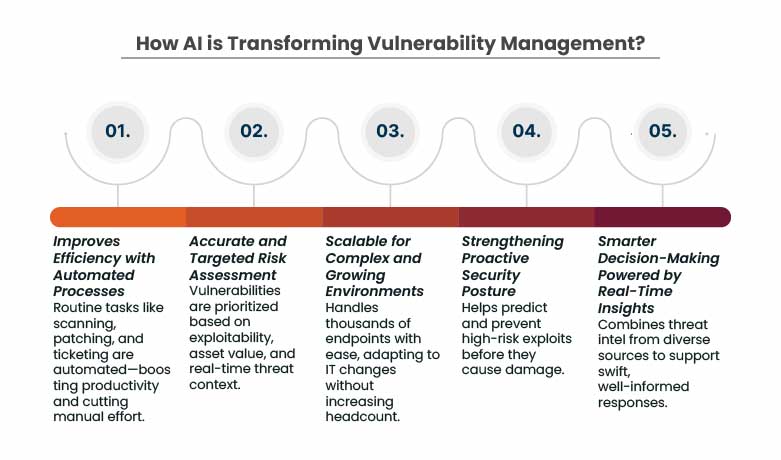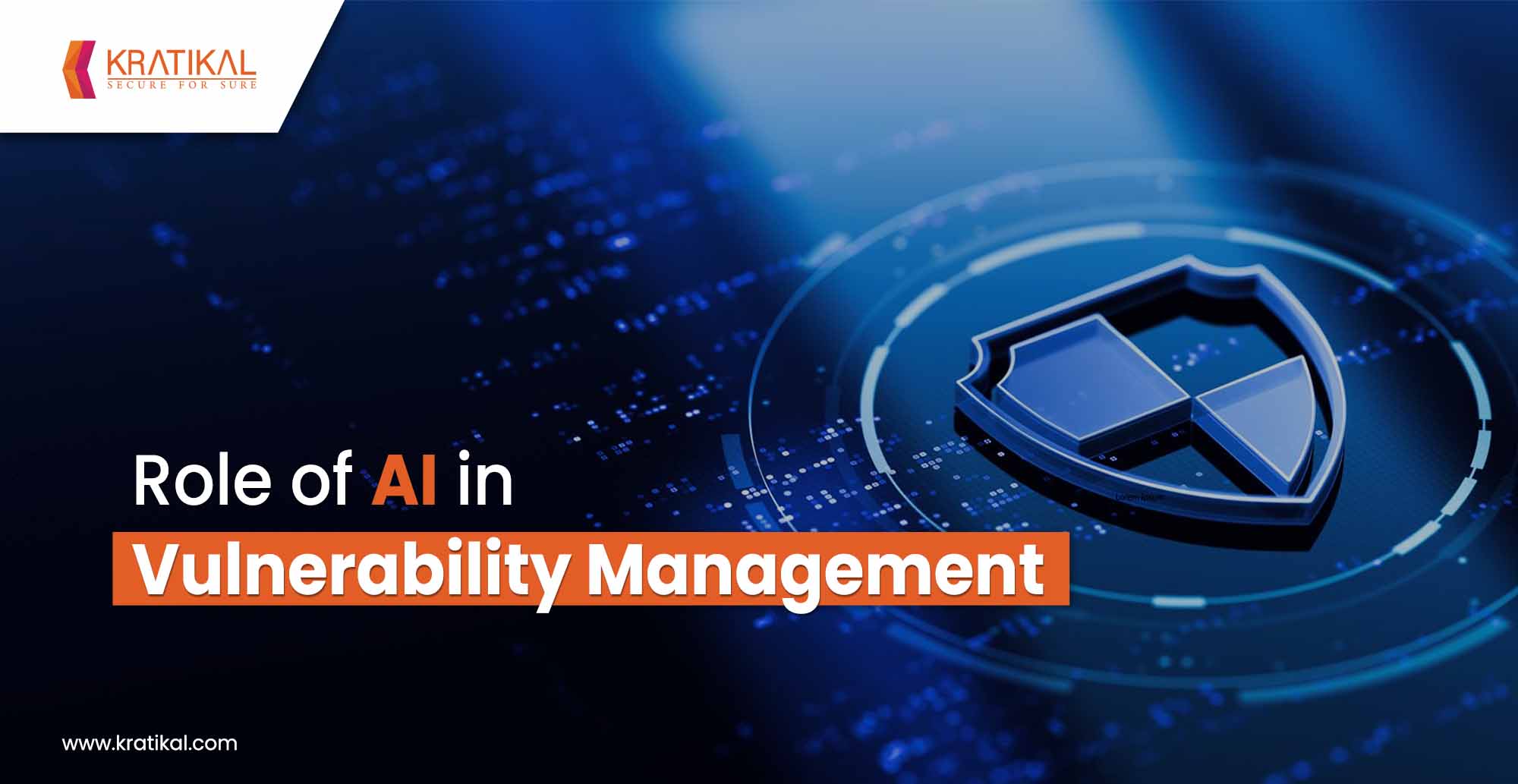Vulnerability management is a continuous process of detecting, prioritizing, and addressing security weaknesses in software applications, networks, and systems. This proactive approach is vital for protecting an organization’s digital infrastructure and ensuring overall security. To streamline and enhance this process, integrating artificial intelligence (AI) is key. AI-powered platforms are revolutionizing vulnerability management by enabling quicker detection, intelligent prioritization, and proactive defense mechanisms. For organizations aiming to enhance their cybersecurity posture without overburdening their teams, AI delivers both speed and scalability. In this blog, we’ll delve into the role of AI in vulnerability management, its benefits for businesses, and the challenges that come with its adoption.
Let’s explore how AI can improve vulnerability management and the ways it can be effectively implemented.
Table of Contents
AI in Vulnerability Management
Integrating AI in vulnerability management significantly elevates its effectiveness. AI not only accelerates analysis but also enhances the accuracy of threat detection.
After choosing to implement AI, it’s essential to define how you want it to respond and determine the types of data it should analyze. This helps in selecting the most suitable algorithms. AI and machine learning techniques are especially powerful in identifying advanced and previously unknown threats.
AI-powered pentesting and VMDR tool like AutoSecT, can analyze massive volumes of data—such as security logs, network traffic, and threat intelligence feeds—to detect patterns and anomalies that may indicate vulnerabilities or active threats. Transforming these logs into structured data and visual charts streamlines the analysis process. Security incidents should be evaluated based on risk severity, with real-time alerts issued for immediate response.
Another key advantage of AI is its ability to self-learn. With continuous training using relevant data, AI systems can adapt to evolving environments and effectively detect both high-risk and previously unknown threats.
While implementing AI does require multiple training iterations—which can be time-intensive—its long-term benefits outweigh the initial effort. Over time, AI models become more adept at identifying vulnerabilities and threats. These systems continuously learn from new data, improving their accuracy and effectiveness in detecting risks and providing actionable insights.
Book Your Free Cybersecurity Consultation Today!
How Generative AI Elevates Vulnerability Management to the Next Level?
Generative AI is redefining the future of vulnerability management by bringing advanced capabilities to threat detection, analysis, and response. Unlike traditional AI models, it can generate new insights, simulate attack scenarios, and offer tailored remediation strategies—making security operations smarter and more adaptive than ever. Here’s how it transforms the game:
Intelligient Automation For Detecting and Prioritizing Vulnerabilities
Generative AI models are increasingly being used to scan code for vulnerabilities at remarkable speed. Combined with AI-powered dark web monitoring and compromised data tracking, organizations can now detect threats in real time—enabling them to act proactively before attackers exploit any weaknesses.
AI Powered Code Remediation
Beyond just detection, AI is also making significant strides in the remediation phase. Tools like AutoSecT, an AI-driven remediation engine, assist developers by offering direct fixes within their development environments. Supporting multiple programming languages, it can resolve a number of vulnerabilities—accelerating the remediation process while maintaining strong security standards.
However, experts advise caution against fully relying on AI-generated fixes. While AI improves digital footprint analysis and strengthens brand protection, human oversight remains essential to ensure accuracy and to prevent the introduction of new bugs.
Role of AI in Vulnerability Management
AI offers a variety of practical benefits for organizations aiming to enhance their security operations without straining their teams or budgets. Here’s how businesses are gaining a competitive advantage by integrating AI in vulnerability management strategies:

Improves Efficiency with Automated Processes:
AI significantly lessens manual effort by automating routine tasks such as asset discovery, vulnerability scanning, ticket assignment, and patch validation. This minimizes time spent on repetitive activities, allowing security teams to focus on more strategic priorities. As a result, organizations can lower operational costs, boost team efficiency, and enhance overall productivity in their security operations.
Accurate and Targeted Risk Assessment:
Unlike traditional static, rules-based systems, AI leverages contextual analysis to deliver more accurate risk assessments. It evaluates factors such as exploitability, network exposure, asset value, known attack patterns, and real-time threat intelligence to identify the most critical vulnerabilities. This targeted approach helps organizations move away from the inefficient “patch everything” mindset, allowing them to focus resources on the highest-risk issues—reducing overall risk while maximizing efficiency.
Scalable for Complex and Growing Environments:
Whether managing 50 or 50,000 endpoints, AI scales seamlessly. It adapts in real time to changes in the IT landscape—such as new devices, software updates, or cloud deployments—without needing a proportional increase in security personnel. As organizations expand or transition to hybrid and cloud-first models, AI ensures vulnerability management evolves accordingly, maintaining strong security without added strain on resources.
Stregthening Proactive Security Posture:
AI shifts vulnerability management from a reactive process to a proactive strategy. By anticipating which vulnerabilities are most likely to be exploited, it enables organizations to take preventive measures before any breach occurs. This approach lowers incident response costs, reduces potential downtime, and supports stronger regulatory compliance by staying ahead of emerging threats.
Smarter Decision-Making Powered by Real Time Insights:
In addition, AI consolidates data from multiple threat intelligence sources—such as CVEs, dark web activity, vendor advisories, and industry reports—to deliver a real-time understanding of the evolving threat landscape. This enables organizations to stay alert and respond swiftly to newly disclosed high-risk vulnerabilities. As a result, decision-makers gain timely, data-driven insights that support faster and more informed security actions.
How AI Agents Automate Threat Detection?
This is where AI truly shines. Unlike traditional systems that rely on predefined rules, AI security agents learn by processing vast amounts of data. They ingest multiple streams of security information to establish a baseline of normal behavior within your systems.
Using advanced techniques such as anomaly detection, natural language processing (NLP), and predictive modeling, these agents can identify unusual activity in real time.
For example:
- A user downloads several gigabytes of sensitive data at 3 a.m. from a foreign IP address.
- A device begins connecting to suspicious domains unexpectedly.
- Multiple failed login attempts are recorded from different locations within minutes.
While such incidents might be overlooked or deprioritized in conventional systems, AI-powered security agents detect and escalate them immediately—often connecting the dots across endpoints, networks, and cloud environments to uncover broader patterns.
Get in!
Join our weekly newsletter and stay updated
Conclusion
Artificial intelligence is transforming vulnerability management from a time-consuming, reactive process into a dynamic, proactive defense strategy. By leveraging AI driven pentesting and VMDR platforms like AutoSecT, organizations can detect, prioritize, and remediate vulnerabilities with unprecedented speed and accuracy. From intelligent automation and self-learning capabilities to real-time risk assessment and scalable deployment, AI empowers security teams to stay ahead of ever-evolving threats without overwhelming their resources.
Generative AI further amplifies these benefits by simulating attack scenarios, enhancing code remediation, and offering context-driven insights that sharpen decision-making. While AI brings immense value, human oversight remains essential to ensure accuracy and prevent unintended consequences.
As cyber threats continue to grow in complexity and frequency, integrating AI in vulnerability management is no longer optional—it’s a critical step toward building a resilient, future-ready cybersecurity posture.
FAQs
- How is AI used in vulnerability management?
AI improves vulnerability management by detecting and prioritizing system weaknesses. Using advanced algorithms, it scans networks to uncover issues such as software bugs and outdated components. It then evaluates the severity of each vulnerability, helping prioritize remediation based on potential risk.
- Ways to use AI in vulnerability management?
By leveraging risk-based prioritization, effective patching cycles, and robust data management, organizations can maximize the benefits of AI while staying protected from cyber threats. Staying vigilant is essential, but so is continuous improvement—regularly evaluating emerging threats, updating AI models, and maintaining compliance.
- What role will AI play in the evolution of vulnerability management?
AI-powered tools like AutoSecT can process large volumes of data and code far more efficiently than traditional methods, minimizing false positives and delivering more accurate vulnerability detection and scoring. AutoSecT also supports real-time monitoring, ensuring organizations receive timely and actionable security insights as new risks emerge.









Leave a comment
Your email address will not be published. Required fields are marked *